flamingobabe
...in the pink (Girls On Spyders)
we cut a hole in mine...change oil easier and lets hot air out
I have removed my splash panels on my ST and also my GS 35,000 miles ago, along with the rear fenders and upper and lower belt guards on both, haven't had a problem with anything, knock on wood.Capt. Jim mentioned removing the splash panels under the ST to help with the heat issue. Also in another thread, Lamont mentioned removing the splash panel on an RT when making your first oil change and leaving it off. I just wonder if leaving the splash panels off of my ST is a good idea if I am cruising on a wet road or run over road debris. Has anyone removed their ST splash panels? If so, any ill effects under different road conditions?
The splash panels are the black plastic pieces below the floor boards, right? Why did you remove all that, do you just like the appearance better or some other reason?
Don't waste your time and money with exhaust wrap, it's worthless for this particular problem. The original purpose of exhaust wrap was to attempt to increase the exhaust gas temperature in an effort to decrease its density. This is called exhaust scavenging and it is an attempt to gain a little more power using the same diameter tubing. Exhaust wrap was not meant to realistically reduce the external temperatures of pipes enough to resolve the problem of external heat dissipation.High Temp exhaust wrap will cure that problem. Wrap as much of the pipe as possible.
The splash panels are the black plastic pieces below the floor boards, right? Why did you remove all that, do you just like the appearance better or some other reason?
Don't waste your time and money with exhaust wrap, it's worthless for this particular problem. The original purpose of exhaust wrap was to attempt to increase the exhaust gas temperature in an effort to decrease its density. This is called exhaust scavenging and it is an attempt to gain a little more power using the same diameter tubing. Exhaust wrap was not meant to realistically reduce the external temperatures of pipes enough to resolve the problem of external heat dissipation.
As I was going through the difficult task of wrapping my exhaust I said to myself: you idiot, you know the laws of thermodynamics, no way this is going to work. And it didn't, not even a little. There is just far too little insulation available with exhaust wrap even when overlapped correctly to possibly contain the constant extreme high temperatures generated by the exhaust. It helps for about the first ten minutes after which the heat just bleeds right through. It may lower the surface temp a little but what real difference does it make if instead of 990 degrees it's 905 degrees? If anyone tells you it works just dare them to grab their wrapped exhaust pipe after the engine has been running for a while. It would take the kind of ultra high tech ceramic heat insulation used on the Space Shuttle to effectively contain the temperatures constantly generated by the exhaust, certainly not a mere eighth inch or so of woven fiberglass or even the "pulverized lava rock" nonsense used in the so-called premium wrap I tried.
The only thing that may help a bit is insulating the tupperware with thick foil covered foam high temp heat insulation wherever the exhaust pipe is nearby. BRP already includes some of this type of insulation, so try adding more. It'll still get hot after a while though so don't expect night and day results.
Don't waste your time and money with exhaust wrap, it's worthless for this particular problem. The original purpose of exhaust wrap was to attempt to increase the exhaust gas temperature in an effort to decrease its density. This is called exhaust scavenging and it is an attempt to gain a little more power using the same diameter tubing. Exhaust wrap was not meant to realistically reduce the external temperatures of pipes enough to resolve the problem of external heat dissipation.
As I was going through the difficult task of wrapping my exhaust I said to myself: you idiot, you know the laws of thermodynamics, no way this is going to work. And it didn't, not even a little. There is just far too little insulation available with exhaust wrap even when overlapped correctly to possibly contain the constant extreme high temperatures generated by the exhaust. It helps for about the first ten minutes after which the heat just bleeds right through. It may lower the surface temp a little but what real difference does it make if instead of 990 degrees it's 905 degrees? If anyone tells you it works just dare them to grab their wrapped exhaust pipe after the engine has been running for a while. It would take the kind of ultra high tech ceramic heat insulation used on the Space Shuttle to effectively contain the temperatures constantly generated by the exhaust, certainly not a mere eighth inch or so of woven fiberglass or even the "pulverized lava rock" nonsense used in the so-called premium wrap I tried.
The only thing that may help a bit is insulating the tupperware with thick foil covered foam high temp heat insulation wherever the exhaust pipe is nearby. BRP already includes some of this type of insulation, so try adding more. It'll still get hot after a while though so don't expect night and day results.
There is heat on the left side near knee and seat.......I would think that shorter people will be affected more....I feel it...the exhaust is not that high....but there is no place for the heat to escape
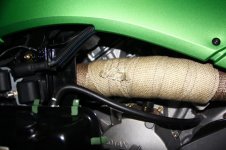
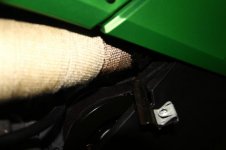
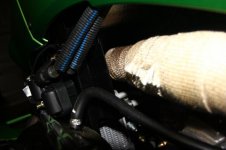
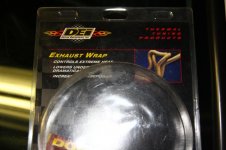
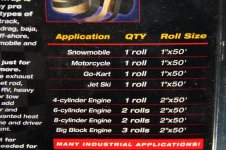
I have the same problem with my 2011 RS-S. I taped my headers with Titanium header tape, it helped but it still hot on a long ride. I'm going to a install heat reflective barrier on the inside of my panels and use an air wing push into the area. That should do it for my RS-S. The big heat problem with the ST's is right under the seat and gas tank is the catalytic converter that creates a lot of heat. One way to remove that much heat is to ducted outside air directly over top of a heat shield that reflects the heat away from of the gas tank and rider. THE POBLEM with both RS's & ST's is you need a fan/fans to move this air when sitting still, like in traffic or stop lights. That's IMHO.
Mike
